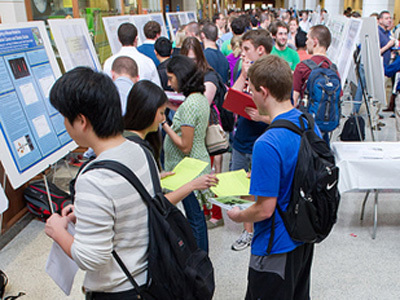
On Friday, Aug. 2, undergraduate researchers who spent their summers in laboratories at the University of Notre Dame, University of Michigan, and Ivy Tech Community College, presented their summer research projects at the Summer Undergraduate Research Symposium in the Jordan Hall of Science.
Research findings were shared as oral and poster presentations throughout the day, with a total of 164 presentations from areas of science and engineering. “As science and engineering become more interdisciplinary and less discipline specific, there are more presentations that appeal to students across the scientific disciplines,” explained Dominic Chaloner, research associate professor of biological sciences and undergraduate research coordinator for the College of Science at Notre Dame.
Notre Dame physics major Kirby Hermansen said that giving formal presentations about his research has helped him improve his scientific communication skills. “The benefit of presenting research is simply gaining the experience,” he describes. “I presented my work at COS-JAM in the spring for the first time and it was not well-structured for my audience. That experience allowed me to get a better grasp of my audience and what was expected of me. My presentation was significantly better this time around.”
Hermansen spent his summer working in the Nuclear Structure Lab (NSL) on a project called, “Carbon 14 AMS: Establishing a Carbon Dating Procedure at Notre Dame.” Accelerator mass spectrometry (AMS) is a method of separating isotopes and isobars of a certain element through a variety of beam analysis techniques.Carbon-14 AMS is complicated by the presence of many contaminants, such as nitrogen-14, that have the same mass-to-charge ratio as carbon-14. He worked on finding optimal settings for the accelerator to avoid the problem ions so that the NSL can collaborate with other departments at Notre Dame on precise dating of artifacts. Hermansen was mentored by Philippe Collon, associate professor of physics at Notre Dame.

Kirby Hermansen with his mentor Prof. Collon.
Brianna Chamberlin presented a poster about her project, “Exploring the Polymorphisum of Piperine.” Piperine, a component of Piper Longum, was studied to determine if the compound exhibited polymorphism, the ability of a crystalline material to form multiple unique packing structures. The discovery of novel crystalline forms is of great importance to the pharmaceutical industry because of the effects unique molecular packing can have on the physiochemical properties of a compound. Using polymer-induced heteronucleation (PIHn) and other crystallization techniques, three novel polymorphs were discovered and one crystal structure has been determined. Chamberlin was advised by Adam Matzger of the Department of Chemistry at the University of Michigan.
Sean McGee gave an oral presentation titled, “Incorporation of Green Design into Field Iodine Deficiency Test.” Iodine deficiency has emerged as the number one preventable cause for mental illness in children in developing countries. A paper analytic device (PAD) can detect iodine in urine, but some of the key ingredients in the test, trivalent and pentavalent arsenic, could lead to significant environmental damage if not disposed of properly. In order to combat these risks, McGee’s project explored the usage of iron oxide nanoparticles to adsorb the arsenic, immobilizing it, and thus removing its toxicity after disposal. McGee was mentored by Kathleen Eggleson from the Center for Nano Science and Technology and Marya Lieberman from the Department of Chemistry and Biochemistry at the University of Notre Dame.
The full abstract book is available on the College of Science website. The symposium was supported by the University of Notre Dame’s Biology REU program, Center for Research Computing, Center for Undergraduate Scholarly Engagement, College of Science, the Graduate School, and NDnano, and the University of Michigan’s Chemistry REU program and the Interdisciplinary REU Program in Structure & Function of Proteins.
Originally published by at science.nd.edu on August 06, 2013.
